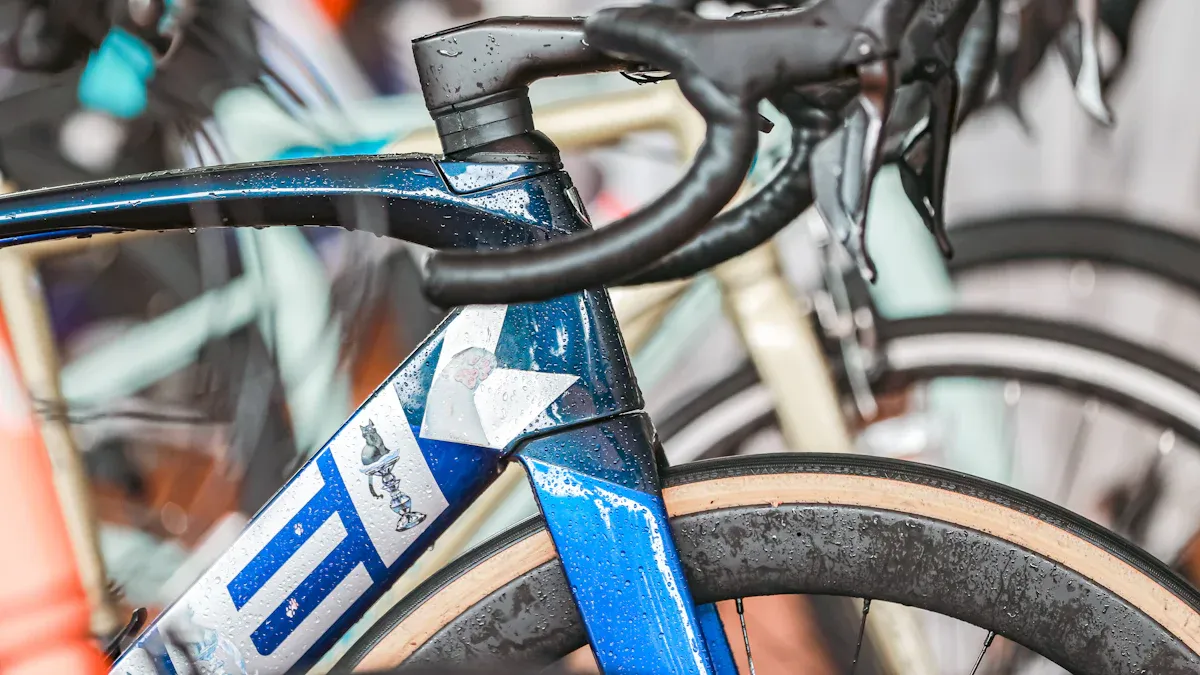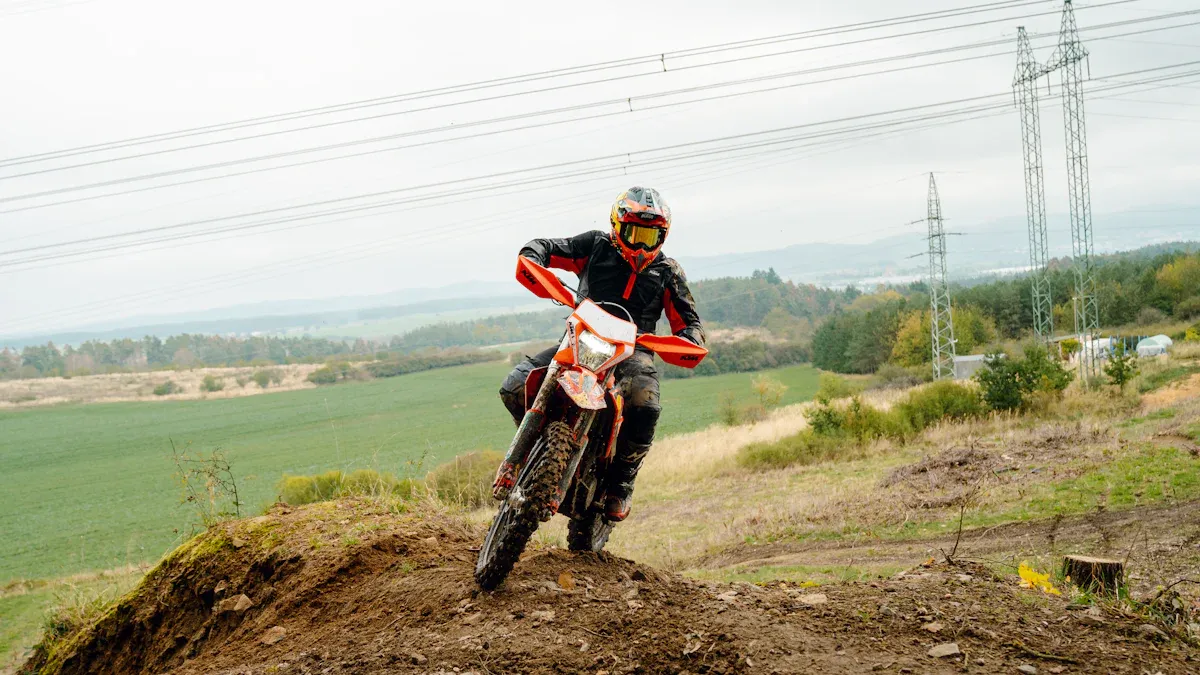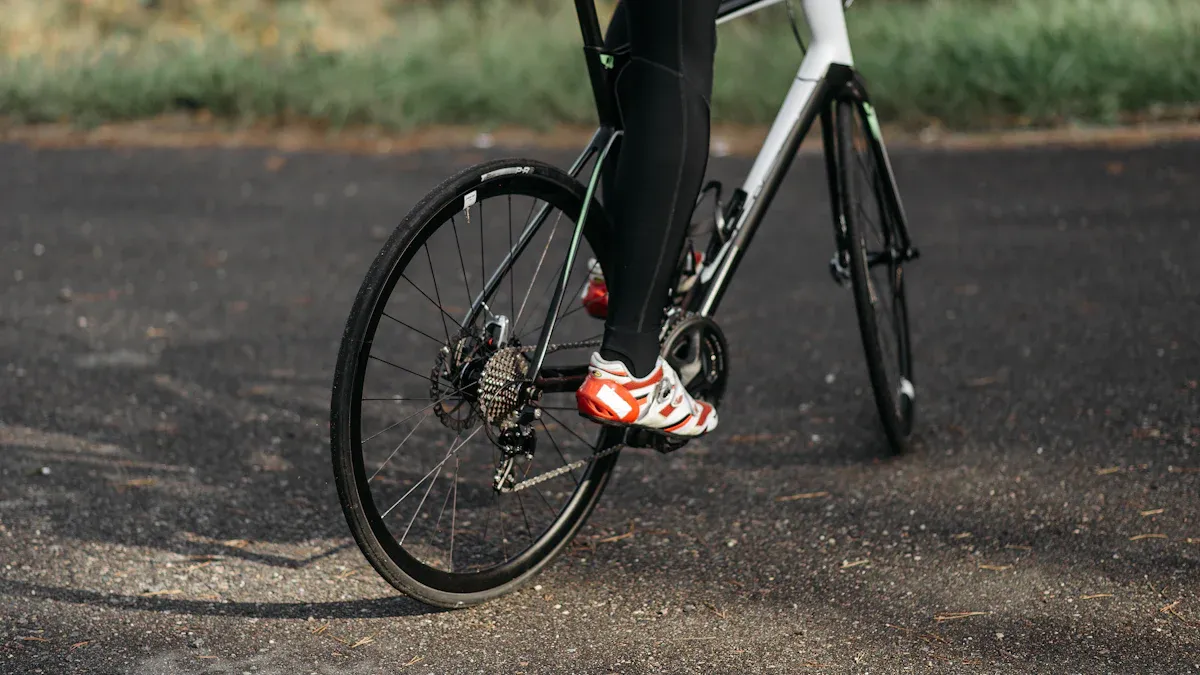
Choosing the right enduro bike frames is very important. It affects how well you ride and enjoy the trails. The enduro bike frames you pick can change how you handle different terrains. Think about your riding style. Are you someone who loves speed or do you like technical rides? Your size is important too. A frame that fits you well makes riding more comfortable and gives you better control. Your personal likes matter as well! Do you want a light bike or a strong one? All these things affect your overall experience with enduro.
Key Takeaways
Pick an enduro bike frame that fits your riding style and skill level. This helps with control and comfort.
Search for strong materials like aluminum or steel. Also, think about frame shape to make riding easier and more stable.
Find the right frame size by measuring your body. Try out different bikes to avoid discomfort and ride better.
Look at different brands and compare prices with features. This helps you find a frame that works for your budget and needs.
Test ride bikes and ask experts for help. This will help you make a smart choice that improves your trail experience.
Riding Style

When you choose your enduro bike frame, your riding style is very important. Different enduro riding styles need different frame features. Let’s look at this more closely.
Types of Enduro
Enduro riding is about climbing tough hills and going down steep paths. Here are some important features of enduro bike frames for this style:
Sturdiness: Enduro bike frames are made to be strong. They must handle rough rides on bumpy ground.
Suspension Travel: Most enduro bikes have long suspension travel, usually from 150-180 mm. This helps soak up bumps, making your ride smoother.
Wider Tires: Enduro bikes often have wider tires. These give you better grip on different surfaces, helping you feel more secure on tricky trails.
Comfort and Durability: When picking an enduro bike frame, focus on comfort and durability. These features help you feel confident on rough paths.
This style is different from others, like cross-country or trail riding. Those have different suspension and frame shapes for their needs.
Skill Level
Your skill level also affects your choice of enduro bike frame. If you’re a beginner, you might want a bike that is easier to ride. Look for frames that are stable and comfortable. These will help you gain confidence as you learn.
If you are more skilled, you might want a bike for aggressive riding. For tough trails with steep drops and tricky turns, choose full-suspension frames with longer travel (140–170mm) and sharp geometry. This setup gives you the stability and control needed for rocky paths.
Don’t forget, the terrain you ride on is important too. For steep climbs and drops, a balanced shape and strong suspension are key. Features like dropper seat posts can help you ride uphill better and control your descent.
Key Features of Enduro Bike Frames

When you choose an enduro bike frame, two main features are very important: frame materials and geometry. These parts greatly affect how your bike works on the trails.
Frame Materials
The materials in your enduro bike frame can change its weight and strength. Most enduro bikes use good materials like aluminum and lightweight steel. These materials are light enough for climbing and strong enough for rough paths.
Aluminum: This is a common choice because it’s light and doesn’t rust. It helps your bike move easily, especially on tricky parts.
Steel: Although it is heavier, steel frames are very strong. They can absorb shocks well, making them good for bumpy rides.
Choosing the right frame material affects how your bike feels and how long it lasts. You want a frame that can handle jumps, rocks, and all the bumps along the way.
Geometry
Now, let’s look at frame geometry. This means the shape and size of the bike frame, which affects how it handles and stays stable. Here’s a quick look at how different geometry parts change your ride:
Geometry Parameter | Impact on Handling and Stability | Effect on Enduro Biking |
|---|---|---|
Head Angle | Slacker angles (62-64°) make the bike stable at high speeds and downhill; steeper angles help with steering. | Enduro bikes have slacker head angles for confidence on steep, tricky trails and stability at speed. |
Reach and Effective Top Tube Length | Longer reach/top tube pushes the rider forward, making it stable at speed but harder to turn; shorter reach/top tube makes it easier to turn but less stable at high speeds. | Enduro riders like longer reach for stable riding positions on descents. |
Wheelbase | A longer wheelbase makes the bike stable on fast descents and rough ground; a shorter wheelbase helps with tight turns. | Enduro bikes usually have longer wheelbases to keep control on tricky descents. |
Bottom Bracket Drop | More drop lowers the center of gravity, making it stable but increasing pedal strike risk; less drop raises the center of gravity, reducing stability. | Enduro bikes balance bottom bracket drop for stability and pedal clearance on different terrains. |
Dynamic Geometry | Geometry changes with suspension movement and rider input, affecting stability and responsiveness. | Enduro bikes use dynamic geometry to keep handling performance across changing trail conditions. |
Knowing about frame geometry helps you pick a bike that matches your riding style. If you like steep descents, look for a bike with a slacker head angle and longer reach. These features give you the confidence to ride steep trails while staying in control.
Sizing Your Enduro Mountain Bike Frame
Getting the right size for your enduro mountain bike frame is very important. A bike that fits well makes you more comfortable and helps you ride better. Let’s see how to measure for the best fit.
Measuring Techniques
To find the right frame size, do these steps:
Consult Manufacturer Size Guides: Look at the size charts from bike makers. They usually suggest frame sizes based on your height.
Measure Your Inseam Height: Stand with your feet apart and measure from your crotch to the ground. This helps you find the right seat tube length.
Review Frame Geometry: Different shapes affect how the bike fits and rides. Check the details of the frame you want.
Adjust for Riding Style: Think about how you ride. If you like aggressive riding, you may need a different fit than if you prefer easier rides.
Test Ride Different Sizes: If you can, try out a few bikes. This helps you feel how comfortable they are.
Consider Your Riding Focus: Different enduro styles, like downhill or uphill, need different frame shapes.
Check Top Tube Length: The top tube length affects how you sit on the bike. Make sure it feels good.
Factor in Personal Preference: Do you like sitting upright or stretched out? Your choice is important.
Account for Brand Differences: Remember that sizes can change between brands because of different shapes.
Consult Cycling Professionals: If you’re not sure, ask experts for help. They can make sure you get the best fit.
Body Proportions
Your body shape is very important when picking the right enduro mountain bike frame. Inseam length helps decide the seat tube length and standover height. A good fit here lets you get on and off the bike easily and safely.
Torso length and arm length affect how far you reach and how the bike fits. This affects your comfort and control while riding. While height charts are a good start, your own measurements are key for getting the right frame size.
Getting a professional bike fitting is a smart choice. It looks at your inseam and torso length along with your riding style. This helps you avoid pain and discomfort, which can hurt your performance. Properly sizing your enduro bike frame gives you the right fit for comfort and handling on trails.
Riding a bike that is not the right size can cause many problems. You might feel pain because of pressure on your body in the wrong spots. Lack of control can make it hard to steer, especially on tough trails or at fast speeds. Performance may drop because of poor power transfer from a frame that is too small or too big. These issues can lead to injuries and ruin your fun. So, getting the right fit is very important!
Comparing Enduro Frames
When you pick your enduro bike frame, it’s important to compare different brands. You should also understand how price and performance work together. Each brand has its own special features. Knowing these can help you make a better choice.
Brand Variations
Different brands have different features and technologies in their enduro bike frames. Here are some well-known brands and what they offer:
Trek: They are famous for their smart designs and reliable rides. Trek frames usually have advanced suspension systems that make your ride better.
Specialized: This brand makes lightweight frames that are great for climbing and going down hills. Their geometry is often made for aggressive riding.
Santa Cruz: If you need a bike for tough terrains, Santa Cruz frames are strong and stable. They are popular with serious riders.
Giant: They give good value for your money. Giant frames perform well without costing too much. They often have a balanced geometry that works for many riding styles.
Each brand has its own strengths. Think about what is most important to you. Do you care more about weight, strength, or advanced technology?
Price vs. Performance
Finding the right mix of price and performance is key when picking your enduro bike frame. Here are some tips to help you with this:
Set a Budget: Decide how much you want to spend. This will help you narrow down your choices and focus on frames in your price range.
Evaluate Features: Look for frames that give you the best features for your budget. Sometimes, spending a bit more can get you a frame with better suspension or materials.
Consider Long-Term Investment: A more expensive frame might last longer and perform better. This can save you money over time. Think about how often you ride and what kinds of trails you go on.
Read Reviews: Check reviews from other riders. They can tell you how well a frame works in real life.
Remember, the most expensive frame isn’t always the best for you. Focus on what fits your riding style and needs.
By comparing different enduro bike frames and understanding brand differences and price-performance balance, you can make a smarter choice. Take your time, do your research, and find the frame that feels just right for your adventures.
Making the Final Decision
Choosing the right enduro bike frame is a big deal, and you want to make sure you get it right. One of the best ways to do this is by test riding the bikes you’re considering.
Test Riding
When you test ride an enduro bike frame, you get a feel for how it handles. Here’s why it’s important:
Comfort: You’ll know if the bike feels good for you. A comfortable ride makes a huge difference on long trails.
Handling: You can see how the bike responds to your movements. Does it feel stable? Can you easily maneuver it?
Fit: You’ll find out if the frame size is right for your body. A good fit helps you ride better and prevents discomfort.
Make sure to test ride different models. Try them on various terrains to see how they perform. This experience will help you make a more informed decision.
Expert Consultation
Don’t hesitate to seek advice from experts. They can provide valuable insights that you might not have considered. Here’s how they can help:
Knowledge: Experts know the latest trends and technologies in enduro bike frames. They can guide you toward the best options for your riding style.
Personalization: They can help you understand what features matter most based on your skill level and the terrain you ride.
Recommendations: They can suggest specific brands or models that fit your needs and budget.
Visiting a local bike shop can be a great way to connect with knowledgeable staff. They can answer your questions and help you narrow down your choices.
By taking the time to test ride and consult with experts, you’ll feel more confident in your decision. Remember, the right enduro bike frame can enhance your riding experience and make every trail adventure enjoyable!
Picking the right enduro bike frame is very important for how you ride. Think about your riding style, skill level, and what you like. A frame that fits you well makes riding more comfortable and gives you better control on trails. Take your time to look at different choices and try out different bikes. This will help you find the best enduro bike frame for you. Enjoy the ride and have fun!
FAQ
What is an enduro bike?
An enduro bike is made for climbing and going down rough trails. It has a strong frame, long suspension travel, and a shape that helps with stability and control on steep hills.
How do I know if an enduro bike frame fits me?
To find the right fit, measure your inseam and check size charts from bike makers. Test riding different sizes helps you see which frame feels best for your body and riding style.
What should I consider when comparing enduro bike frames?
Look at frame materials, shape, and suspension travel. Each brand has special features, so think about your riding style and budget to find the best fit for you.
Can I upgrade my enduro bike frame later?
Yes! You can upgrade many parts, like suspension and wheels. Just make sure the new parts work with your current frame to keep it performing well.
How often should I maintain my enduro bike frame?
Regular maintenance is very important. Check your frame for cracks or damage after each ride. Clean and lubricate moving parts often to keep your bike in great condition.
